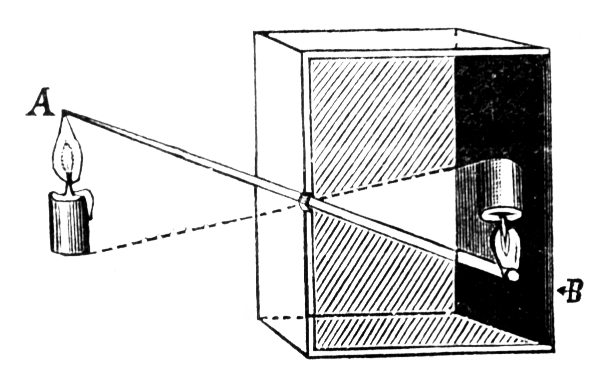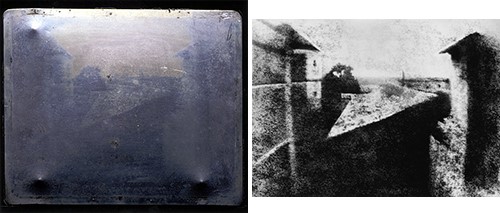Since prehistoric times man has been making images of himself and the world around him. Until comparatively recently the processes involved have required skills possessed by only a few privileged individuals. The growth of portraiture in Europe from the time of the Renaissance was restricted to those wealthy enough to commission a painting. During the 18th century a growing middle class created a demand for less expensive methods of preserving an image of themselves. To some extent this demand was met by miniature painters, whose work was suited in both scale and cost to smaller homes. However, it was the silhouette that first satisfied mass demand.
Pictures traced from the shadow cast by a lamp or cut freehand from black paper (literally a profile picture), first became popular in the early 18th century. They were named after Etienne de Silhouette, a French finance minister and amateur profile maker. Although the silhouette was relatively inexpensive, each one had to be drawn or cut individually. There was no faster way to create duplicates, so a copy cost just as much as the original. The first system producing multiple copies of a portrait was invented by Gilles Louis Chretien in 1786. With his apparatus a profile cast by a lamp onto a glass plate was traced by an operator using a pointer connected to an engraving tool moving over a copper plate. The finished engraved plate, with added details of features and costume, could be inked and printed many times. Chretien called his device the Physionotrace. These mechanical methods of making images were cheap, but could not rival the much more costly and skilled art of miniature painting, the products of which were full of detail and colour.
Inventors and artists began to speculate whether light could be used to produce a picture directly, cheaply and without special skills. Not only would a suitable optical device be required to produce an image, a surface capable of permanent alteration on exposure to light must be prepared to receive it.
Both these principles had been established by the beginning of the nineteenth century. If a small hole is made in the wall of a darkened room an image of the outside world will be produced on the opposite wall. The image will be inverted and dim; if the hole is enlarged there will be a brighter but less well-defined image.
Camera Obscura

A Camera Obscura is a dark box or room with a small hole in one of its outside facing walls that lets in light to produce an upside down and backwards image on the opposing wall. The tool was commonly used for artists to trace their subject matter, rendering perspective with complete accuracy.
The phenomenon of the Camera Obscura (Latin for ‘dark room’) had been observed in ancient times. The concept of capturing light was mentioned by Chinese philosopher Mozi (470 to 390 BC), understood by Greek philosopher Aristotle (384 to 322 BC), and first recorded in descriptions by Arabian scholars circa 900 AD. In the 13th century Roger Bacon described its use to safely observe solar eclipses and as early as the 15th century, its use as a drawing aid for artists became apparent. Leonardo da Vinci (1452-1519) described its use in his notes: “When the images of illuminated objects pass through a small round hole into a very dark room… you will see on the paper all those objects in their natural shapes and colours. They will be reduced in size, and upside down, owing to the intersection of the rays at the aperture.”

Clearly this was a useful effect for artists and the Camera Obscura was recommended by Italian scholar Giovanni Battista della Porta in 1558 in his book Magia Naturalis (Natural Magic). He suggested that a brighter and clearer image could be produced by replacing the small hole with a convex lens or concave mirror. He also proposed that an optical system could be used to transmit from room to darkened room the images of actors for entertainment. During the following 300 years the Camera Obscura was a feature of many public and private buildings. Even today a few are still in operation and can be seen at several places in Great Britain, notably Edinburgh and Bristol.
To make the Camera Obscura practical for use by artists, more convenient versions were made as collapsible tents with lenses and mirrors or prisms at the apex, displaying the image on a horizontal table surface. Portable forms were made from small wooden boxes with a moveable lens at the front, focusing an image on a ground-glass screen at the rear. An important 18th century refinement introduced a mirror behind the lens to reflect the image onto a horizontal ground-glass screen in the top, usually screened by a hinged lid. This most popular form of Camera Obscura was widely used by artists who could copy or trace the image, simplifying the problems of accurately rendering form and perspective. It was this device that was to evolve into the photographic camera.
Capturing Light
Since ancient times there was scientific awareness that light has an effect on certain materials. Some fade on exposure, others darken. The latter is especially true of certain compounds of silver. The first recorded scientific study of this was by German scientist Johann Heinrich Schulze in 1727. He filled a glass bottle with a suspension of chalk and silver in nitric acid and demonstrated that when exposed to light the mixture turned from white to a dark purple. By attaching stencils of black paper to the outside of the bottle he was able to print images of letters and shapes on the mixture. His discovery did not reveal a method to preserve an image, however, as they were destroyed when the liquid mixture was disturbed and the silver salts continued to darken unless protected from light. In 1777 Carl Wilhelm Scheele showed that this darkening of silver compounds from light was due to the formation of metallic silver.
In the late 1790s Thomas Wedgewood, son of the founder of Wedgewood pottery, was one of the first experimenters to try to make practical use of Schulze’s discovery. Perhaps as a result of working with his father’s Camera Obscura which was used in the design of pottery decoration, Wedgwood saw potential for the device to record an image directly onto paper. Aware of the published reports of Schulze and Scheele, he naturally turned to silver compounds. He experimented with using paper or white leather coated with silver nitrate to capture silhouette images and images projected with a Camera Obscura. Whilst he was not able to ‘fix’ the image once exposed (further exposure to light caused the image to eventually disappear), his attempts and limited success have led him to be considered by many to be “the first photographer.”
His experiments were described by his friend, and revered chemist, Humphry Davy (inventor of the Davy lamp), in a paper presented to the Royal Institution. Published in The Journals of the Royal Institution (No. 9, 22 June 1809), the paper was entitled “An account of a method of copying paintings upon glass etc., invented by T. Wedgwood Esq., with observations by H. Davy”. This is how Wedgwood’s experiments were described:
“White paper, or white leather, moistened with solution of nitrate of silver, undergoes no change when kept in a dark place; but, on being exposed to the day light, it speedily changes colour, and, after passing through different shades of grey and brown, becomes at length nearly black… outlines and shades of paintings on glass may be copied, or profiles of figures procured, by the agency of light. When a white surface, covered with solution of nitrate of silver, is placed behind a painting on glass ex-posed to the solar light, the rays transmitted through the differently painted surfaces produce distinct tints of brown or black, sensibly differing in intensity according to the shades of the picture, and where the light is unaltered, the colour of the nitrate becomes deepest.”
"…After the colour has been once fixed upon the leather or paper, it cannot be removed by the application of water, or water and soap, and it is in a high degree permanent. The copy of a painting, or the profile, immediately after being taken, must be kept in an obscure place. It may indeed be examined in the shade but, in this case, the exposure should be only for a few minutes; by the light of candles or lamps, as commonly employed, it is not sensibly affected."
"…the images formed by means of a Camera Obscura, have been found to be too faint to produce, in any moderate time, an effect upon the nitrate of silver. To copy these images, was the first object of Mr. Wedgwood, in his researches on the subject… Nothing but a method of preventing the unshaded parts of the delineation from being coloured by exposure to the day is wanting, to render the process as useful as it is elegant."
It is surprising that Davy, a leading chemist of his day, could not suggest any chemical method of removing the unused silver salts so as to ‘fix’ the image as Davy likely had access to some materials which would have given some permanence to the pictures. However in 1805 Wedgwood died without developing the discovery that was so close to being a practical proposition.
Permanent Images
The first permanent images made directly by light were produced by the Frenchman Joseph Nicephore Niépce. In the early years of the 19th century Niepce, an amateur scientist, inventor and artist, became interested in the relatively new techniques of lithography, which had just been invented at the end of the 18th century by Aloys Senefelder. Niépce had previously relied upon the sketches made by his son for his scientific experiments. When his son went off to war in the Napoleonic period, the elder Niépce, not being able to sketch himself, conceived the idea of trying to capture an image directly in a camera instead.
Like Wedgwood before him, Niepce first tried sensitizing paper with silver chloride; in 1816 he was able to record faint images in the Camera Obscura, but was unable to make the pictures permanent. He then tried coating metal plates with various acid-resisting substances, hoping to make printing plates. He discovered that a coating of varnish made by dissolving bitumen of Judea (a kind of asphalt) in a suitable solvent was sensitive to light. Since the varnish hardened if exposed for a long period, if the coated plate were placed under an engraving on translucent paper the lines of the picture protected the bitumen from light and it remained soft. Where light passed through the engraving, the bitumen hardened and became insoluble. After exposure the plate was washed with a mixture of light petroleum and lavender oil, which dissolved away the soft unexposed parts of the coating, leaving a permanent image on the plate. Niepce’s first ‘heliographs’ were produced in 1822; in 1826 or 1827 he succeeded in recording an image on a bituminised pewter plate in a Camera Obscura. An eight-hour exposure produced a faint but identifiable image of the scene from an upper window of Niepce’s home at Saint-Loup-de-Varennes, in France, known today as the View from the Window at Le Gras. This photograph, the oldest surviving image produced in a camera, is preserved in the Gernsheim Collection at the University of Texas.

View from the Window at Le Gras (1826-7)
Niépce’s heliographic process was quite impracticable for normal photography due to the very long exposures required, although in a modified form it was later used for his original objective of producing plates for printing. Niépce would go on to collaborate with Louis Jacques Mande Daguerre and the heliograph would evolve into something much more practical - the Daguerreotype.
